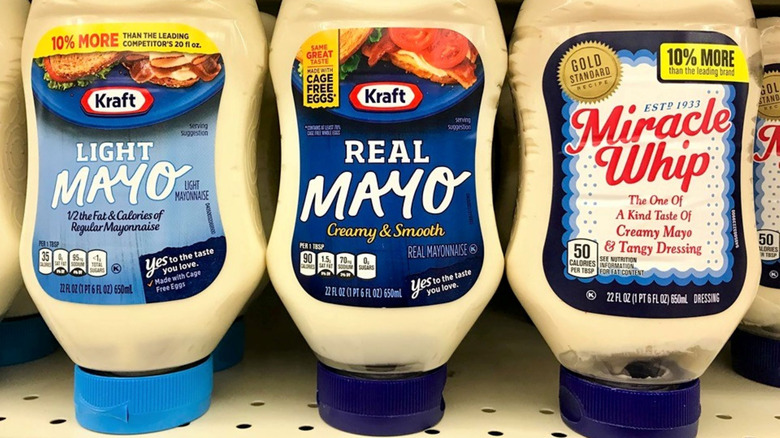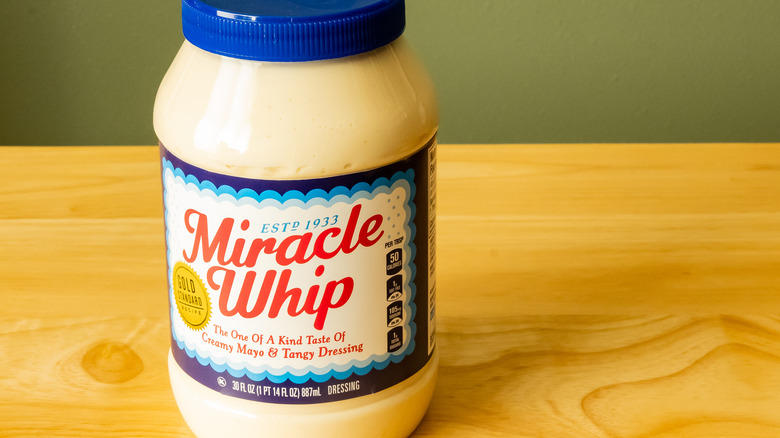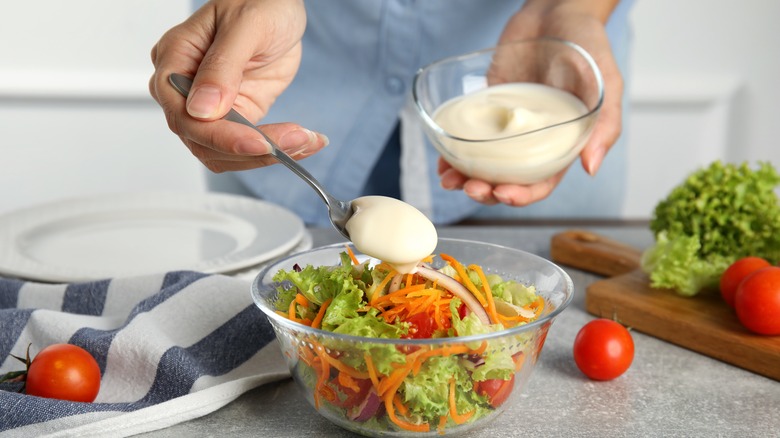The Key Flavor Difference Between Mayo And Miracle Whip
Few culinary topics ignite as fiery a debate as the one asking whether mayonnaise or Miracle Whip is better. People on both sides of the condiment aisle are firm in their convictions, and because the debate is so intense, they can rarely be swayed to the other side. Mayo and Miracle Whip are virtually identical in appearance, are used for basically the same purposes, and are sold in the same aisle of the supermarket. Are they really so different after all? Yes — yes, they are.
Mayonnaise, a creation of the French, has existed for hundreds of years, while Miracle Whip is relatively newer in food history, developed in America by Kraft Heinz in 1933. While the two share some ingredients, Miracle Whip is noticeably sweeter than mayonnaise, and let's not forget its signature "tangy zip." You might also notice that the word "mayonnaise" isn't found on the label of Miracle Whip jars, despite its similar appearance to the sandwich favorite. This is because the U.S. Food and Drug Administration maintains that any condiment labeled as mayo must be made with 65% vegetable oil. Miracle Whip does contain this type of oil, but not enough to be deemed as its predecessor. Instead, it's called a "dressing," one that can sweeten up a sandwich, salad, or dip.
Sugar gives Miracle Whip its signature sweetness
Mayonnaise is essentially a thick emulsion of egg yolks, oil, and an acid, such as vinegar or lemon juice. Miracle Whip contains the same ingredients, but is made with less oil and also includes water, sugar, mustard, paprika, and garlic. The popular mayo brand Hellmann's, or Best Foods, also contains some sugar, but not as much as Miracle Whip, and not enough to be described as "sweet." When you taste Miracle Whip, the sugar and sweetness are obvious, and this is precisely what many fans like about the dressing.
While Miracle Whip is lower in calories than mayonnaise due to the decreased amount of oil, it is also not as thick as its competitor because it contains water. As for why a mayonnaise alternative was even necessary or desired, the answer lies in the time of the Great Depression when ingredients like eggs were rationed and scarce. Therefore, Miracle Whip was simply cheaper to make and sell. It was during this same era that desserts like water pie became popular.
Are mayonnaise and Miracle Whip interchangeable?
In a pinch, Miracle Whip can be used in place of mayonnaise, and vice versa, pretty much across the board. Both work on sandwiches, mixed into tuna, chicken, and egg salads, and are used to make things like deviled eggs. But if you like the taste of Miracle Whip, it will really shine in recipes that might benefit from a little sugar, like coleslaw, macaroni salad, and Waldorf salad. The one area where you shouldn't substitute Miracle Whip for mayonnaise is in baking. Baking relies on precise amounts of ingredients like oil and eggs, and when a recipe calls for mayonnaise, like a chocolate cake made with mayo, the decreased amount of oil and the addition of water in Miracle Whip could adversely affect the results.
Ultimately, the decision to swap mayonnaise and Miracle Whip comes down to personal taste. If it's the classic, eggy taste of mayonnaise you crave, stick with real mayo. If you don't mind extra sweetness and a bit of thinner consistency, you might join the devoted group of die-hard Miracle Whip fans.



